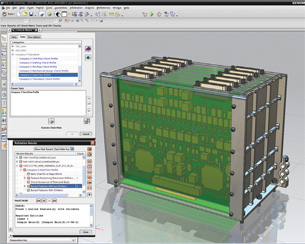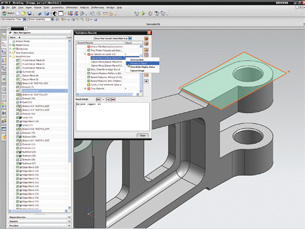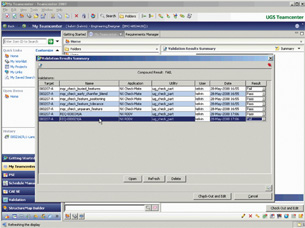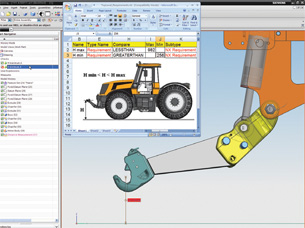Latest News
May 3, 2009
By Taylor Anderson
 In under a second, Check-Mate finds two modeling errors in an assembly of 3700 components. |
As CAD modeling techniques become more and more advanced, with both parametric feature-based modeling and breakthroughs such as synchronous technology becoming more widely used, senior management is starting to realize that product modeling and design changes can be completed much faster than ever before. However, these efficiently created designs still need to be checked and re-checked to ensure they meet the drawing and model design standards set by the organization, its customers, and the industry at large. The trick is to manage and automate the design validation process to make sure neither time to market nor product quality are adversely affected.
Validation Issues
The problems associated with drawing and CAD model validation can be broken into three broad areas—productivity, quality (product and CAD model), and process management. First, designers can spend a significant amount of time continually checking their models for problems or mistakes, and then re-checking them after design changes have been made. As design productivity continues to increase, the checking process can become a bottleneck in the product-development process.
Second, CAD users must meet an ever-increasing variety of design criteria and targets. If a mistake goes undetected due to human error or because the designer is unaware of a particular industry standard, errors can propagate from the CAD model into analysis and to manufacturing, hurting product quality and, ultimately, product delivery.
Finally, the quantity and diversity of CAD drawing and model standards as well as design-specific criteria can be overwhelming, whether you are a large OEM or a small supplier working with several different clients. Companies need a way to effectively manage these standards so no problems fall through the cracks and efficient product design is maintained.
 Check-Mate helps users quickly navigate the model to find and fix errors. Much of its capability can be automated. |
Given these challenges, it starts to become clear that it is important to not only automate the validation process, but also to automate the initiation of the checking function to ensure that validation takes place when it can be most effective (e.g., providing immediate feedback when a modeling mistake or design spec violation occurs). In addition, it is necessary to automate the tracking of design requirements and integrate the requirements management process with the design process.
Validation Productivity & Quality
When considering how to increase productivity in design checking and validation, there are two areas that need addressing—standards validation and design-specific validation.
Standards validation refers to checking all aspects of a design to ensure it adheres to company standards for model creation (use of layers, colors, etc.), drafting standards (tolerance callouts, font size, etc.), and discipline-specific best practices (e.g., minimum bend radius on pipe runs or corner reliefs on sheet metal components). The checks performed in this particular context are not part specific.
The second class of validations is the checking of individual design targets or critical measurements. These checks are much more design specific and are focused on ensuring that a particular design implementation meets important functional criteria, rather than general company or industry standards. These requirements can influence the form, fit, or function of the design and could include part-specific specifications such as dimensional tolerances, weight limits, or minimum clearance between parts. Requirements of this type are often stated in product-specification documents. The design system should be able to perform automatic validation using requirements defined in a variety of places, including requirements management tools, XML files, or even Excel spreadsheets.
 Validation Results for each part (for both Check-Mate and Requirements Checks) can be stored in Teamcenter and used to control release workflows. |
Whatever type of validation is being performed, it is best done automatically and without any direct user interaction during the checking process. Full automation is an important step toward ensuring that validation is performed consistently, and ensuring that resulting quality metrics are actually useful. When problems are detected, the user should receive immediate feedback and then have full control to perform further validation interactively and thereby resolve the problem.
This automated checking with immediate feedback can have significant impact on a company’s bottom line. In addition to its potential to dramatically reduce the time spent checking a design, it also shortens the lifespan of a problem, thus minimizing the likelihood that the problem will be consumed by a downstream process and start a cascade of additional problems. The result is significantly improved productivity and quality. Furthermore, if designers are notified immediately that they have violated a company design standard or industry practice, they’ll not only correct the mistake, but also learn from the process. This helps train the designers, makes them more efficient, and gives them a high degree of confidence that they are meeting all model and design requirements.
Managing Validation with PLM and CAD
Of course, the task of keeping track of the sheer volume of design requirements, CAD practices, and industry standards can be a daunting challenge—and these requirements can change over time. This is why it is critical that the information is captured and maintained in digital formats that can be tied to or integrated with the specific design system.
NX Check-Mate for example, is part of Siemens PLM Software’s NX CAD application and enables standards-based checking to ensure file structure consistency as well as adherence to a variety of corporate and industry standards.
 In this example, a Requirements Check is used to validate the operating envelope of a tractor mount. |
Siemens PLM Software’s Teamcenter Requirements application provides a way to easily store and modify all requirements and then tie directly into the NX CAD application. In so doing, it efficiently and continuously validates designs against these requirements. NX can similarly validate requirements stored outside the CAD design in Excel spreadsheets or XML files. We refer to this capability as Requirements-Driven Design Validation, or RDDV.
These validation tools can be run interactively or set to run automatically, enabling companies to tailor their validation solution to suit their processes.
To get maximum value from increasing the levels of validation it is important that the validation results are stored alongside the validated parts in useful ways. Validation results can be an important tool within the context of part-release workflows, helping to ensure that only validated parts are released. Reporting of these results should be presented graphically in easy-to-understand formats that can be used throughout the company. Quality Dashboard tools allow reports to be generated and model quality to be monitored as part of an ongoing process to address and improve overall design quality.
By managing the design validation process, engineers can use the newest advanced design techniques with a high level of confidence and consistently deliver higher-quality designs faster.
More Info:
Siemens PLM Software
Plano, TX
Taylor Anderson is the NX product manager for Siemens PLM Software. You can send comments about this article to [email protected].
Subscribe to our FREE magazine, FREE email newsletters or both!
Latest News
About the Author
DE’s editors contribute news and new product announcements to Digital Engineering.
Press releases may be sent to them via [email protected].






